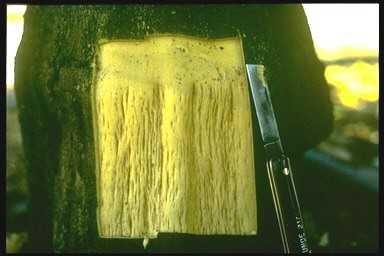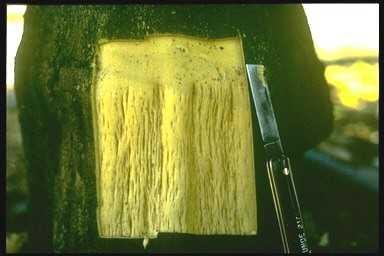

Citrus tristeza virus (CTV)
CTV has been found in all citrus growing areas of the world. It is spread by infected propagative material and several species of aphids (Toxoptera citricidus, T. aurantii, Aphis gossypii, A. craccivora, A. spiraecola and Myzus persicae).
T. citricidus is the most efficient vector of CTV. The virus has also been transmitted from plant to plant by the use of dodder (Cuscuta americana and C. subinclusa). CTV is not transmitted through citrus seeds. Most species of Citrus are hosts for CTV. The virus has naturally occurring field strains, which vary considerably in their ability to cause symptoms on different host plants and in the intensity of the symptoms expressed.
Symptoms caused by these strains include:
Seedling yellows (SY): This symptom consists of leaf yellowing and stunting in sour orange, grapefruit and lemon seedlings. This is a field problem when trees infected with SY strains of CTV are top-worked with grapefruit or lemon.
Decline on sour orange: Sweet orange, grapefruit or tangerine scions on sour orange rootstock become dwarfed, yellow (chlorotic), and often die. The decline may occur over a period of several years or very rapidly (quick decline). Trees that decline slowly generally have a bulge (swelling) above the bud union, and honeycombing (many fine holes or pitting) is present on the inner face of bark flaps removed from the sour orange rootstock. When trees decline rapidly, honeycombing does not occur, but a brown line may be observed at the bud union after the bark is removed. When budwood infected with decline-inducing strains is propagated on sour orange seedlings, the trees produced are stunted and unthrifty.
Stem-pitting on limes, grapefruit and sweet orange. Severely affected trees are stunted and may have bushy appearance. Leaves are yellow, and the twigs are brittle and break easily when bent. When the bark is removed from the affected twigs, elongated pits are seen in the wood. Trees affected by stem pitting have reduced yield and fruit quality is poor. Some strains cause longitudinal pits in the trunk, resulting in ropey appearance, and when bark is removed from the depressed parts deep pits can be seen in the wood.
- A practical safeguard against CTV is to use only disease-free budwood and to ensure that they budded onto tolerant rootstocks.
- In Brazil, where CTV has been the major problem of citrus, its control has been achieved by use of budlines pre-immunized with mild strains of the virus to protect against severe strains.
- It is, economically, impossible to prevent CTV spread by aphid control. However, selected control, at early stages of infection and during periods with high aphid populations, reduces the rate of spread.
- Remove infected trees.
- Rootstock varieties generally considered tolerant to CTV are Sweet orange, Cleopatra mandarin, Rough lemon, Rangpur lime and Trifoliate orange.
Citrus tristeza virus (CTV)
